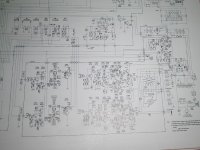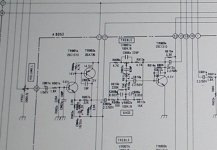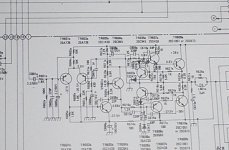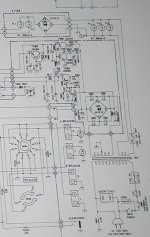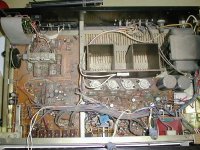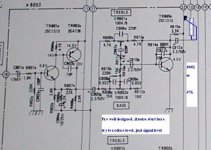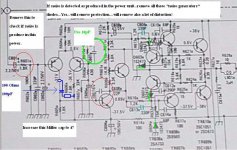I have an old 35W/ch realistic receiver which has developed a substantial hiss in both channels. I am going to try to fix it myself and I wanted to run my ideas past you folks and see if I am on the right wavelength.
I have the schematic (RS was nice and provided it in the owners manual - wish that were more common). The layout is as follows.
- PS is unragulated to the power amp and regulated with discrete transistor circuit for the other sections.
- Power amp is differential input plus one gain stage feeding what appears to be a quasicomplementary output stage with LC coupling to the speaker outputs.
- Headphone output is just a 330ohm resistor in line with the speaker output.
- Preamp has individual left and right volume controls (sliders). After the volume control there is an emitter follower type buffer followed by the tone controls including a CE output stage whice feeds the differentail pair of the power amp.
- Phono and tuner sections are all IC based.
The hiss occurs any time the power is on and is uneffected by volume control possition or source selected. The treble control and high filter that is located after the preamp do effect the quality of the hiss.
So I deduce that the problem is either in the preamplifier circuitry or the regulated power supply which powers it.
I do not have a scope so I will have to use simple methods.
Here is what I propose. I will visually examine the preamp and regulator boards for obviously damaged components and loose connections. If nothing presents itself I would hook up some junk speakers and gently probe with a pencil eraser while listening for a change in the hiss. I suspect either bad solder joints or flakey resistors.
Am I on the right track? Any other suggestions?
mike
I have the schematic (RS was nice and provided it in the owners manual - wish that were more common). The layout is as follows.
- PS is unragulated to the power amp and regulated with discrete transistor circuit for the other sections.
- Power amp is differential input plus one gain stage feeding what appears to be a quasicomplementary output stage with LC coupling to the speaker outputs.
- Headphone output is just a 330ohm resistor in line with the speaker output.
- Preamp has individual left and right volume controls (sliders). After the volume control there is an emitter follower type buffer followed by the tone controls including a CE output stage whice feeds the differentail pair of the power amp.
- Phono and tuner sections are all IC based.
The hiss occurs any time the power is on and is uneffected by volume control possition or source selected. The treble control and high filter that is located after the preamp do effect the quality of the hiss.
So I deduce that the problem is either in the preamplifier circuitry or the regulated power supply which powers it.
I do not have a scope so I will have to use simple methods.
Here is what I propose. I will visually examine the preamp and regulator boards for obviously damaged components and loose connections. If nothing presents itself I would hook up some junk speakers and gently probe with a pencil eraser while listening for a change in the hiss. I suspect either bad solder joints or flakey resistors.
Am I on the right track? Any other suggestions?
mike
Hi Mike,
The amplifier may be oscillating supersonically. A 'scope would be really helpful here. If one channel becomes unstable, both channels may break into oscillation. Especially if the supply bypass capacitors have degraded.
Check to see if the resistors in the zobel network get warm or have been overheated. This is a sure sign the amp is or has been oscillating. I don't think there is much use in wholesale replacement of parts until you have some idea as to what is going on.
-Chris
The amplifier may be oscillating supersonically. A 'scope would be really helpful here. If one channel becomes unstable, both channels may break into oscillation. Especially if the supply bypass capacitors have degraded.
Check to see if the resistors in the zobel network get warm or have been overheated. This is a sure sign the amp is or has been oscillating. I don't think there is much use in wholesale replacement of parts until you have some idea as to what is going on.
-Chris
I was thinking of the same thing (or at least that it's in the power amp section) in part because I came to the opposite conclusion of the poster from his description. If the volume control has no influence then it seems likely the problem is likely "downstream" from that point. This leaves all of the power amp section suspect and only those parts of the preamp section that come after the volume control.
This probably doesn't help a lot but hopefully it directs attention to the regions where the mosy likely suspects live.
This probably doesn't help a lot but hopefully it directs attention to the regions where the mosy likely suspects live.
I appreciate the input and hope for even more. 
The reason that I think it is before the power amp is that the tone controls do effect the hiss. If it were in the power amp I would expect the tone controls to have no effect. The volume control is the very first thing in the preamp section (except when phono is switched in). Down stream from the volume controls (I agree here) but before the tone controls puts it right in the heart of the preamp section right? Or am I not understanding something here?
mike
I was thinking of the same thing (or at least that it's in the power amp section) in part because I came to the opposite conclusion of the poster from his description. If the volume control has no influence then it seems likely the problem is likely "downstream" from that point. This leaves all of the power amp section suspect and only those parts of the preamp section that come after the volume control.
The reason that I think it is before the power amp is that the tone controls do effect the hiss. If it were in the power amp I would expect the tone controls to have no effect. The volume control is the very first thing in the preamp section (except when phono is switched in). Down stream from the volume controls (I agree here) but before the tone controls puts it right in the heart of the preamp section right? Or am I not understanding something here?
mike
Or am I not understanding something here?
No, not at all. Given that most of the preamp is downstream from the volume controls what you say makes sense. In fact know I suspect you may want to focus on what lies between the volume controls and the tone controls, including the tone contol circuits themselves.
Tone contols usually involve capacitors. Electrolytic capacitors are a component generaly considered to have a limited life so I would put them high on the list of suspects. Resistors are probably least likley. Film capacitors are pretty durable as well. Ironicly resistors are the easiest to check (keeping in mind situations where there are parrallel resistors) in circuit while capacitors have to be removed.
Since you have a DMM you can at least check the resistor values fairly easily. They will probably be OK but at least you can eliminate them from further attention.
A bad solder joint is also possible. Re-melting each one might be something to consider. Older components were more easily damaged by heat, or so I'm told, so don't let the iron linger any longer than needed.
Some tone controls are in the feedback network. Not having the schematic to look at, I can't answer that.
We suspect something is oscillating - but what? Capacitors, as sam9 and I have pointed out, are the most likely suspect here. Resistors will generally not cause this.
Short the input feeding the amp section to ground, not on the amp side of the coupling cap!. The value of input resistance can make an amplifier unstable. Open input caps can do this. Anyhow, check if the hiss is still there. If so, the fault is in the amp section for sure. Keep in mind the tone controls may be part of the amp circuit.
-Chris
We suspect something is oscillating - but what? Capacitors, as sam9 and I have pointed out, are the most likely suspect here. Resistors will generally not cause this.
Short the input feeding the amp section to ground, not on the amp side of the coupling cap!. The value of input resistance can make an amplifier unstable. Open input caps can do this. Anyhow, check if the hiss is still there. If so, the fault is in the amp section for sure. Keep in mind the tone controls may be part of the amp circuit.
-Chris
Finally got around to opening it up
I finally got around to opening it up. I powered it up and checked a couple of quick things.
Nothing appears to be getting hot. I checked for AC and DC voltage on the output transistor cases (easy to get to) and two inside cases are at 37Vdc with no measurable AC (using VOM).
I am attaching some pictures of the schematic and the chassis for you to get an idea.
mike
Most of the schematic
I finally got around to opening it up. I powered it up and checked a couple of quick things.
Nothing appears to be getting hot. I checked for AC and DC voltage on the output transistor cases (easy to get to) and two inside cases are at 37Vdc with no measurable AC (using VOM).
I am attaching some pictures of the schematic and the chassis for you to get an idea.
mike
Most of the schematic
Attachments
And finally
A picture of the top side.
I just had a thought. The hiss is the same in both channels so I wonder if that would implicate a PS issue since the chance of both preamps failing in the same way seems remote. Any merit to that line of thinking?
mike
A picture of the top side.
I just had a thought. The hiss is the same in both channels so I wonder if that would implicate a PS issue since the chance of both preamps failing in the same way seems remote. Any merit to that line of thinking?
mike
Attachments
Yes.Any merit to that line of thinking?
...and dust that filthy thing off, fer Christ's sake...

Try to clean it, or unless use your wife hair drier to heat all those sediments that
The dust over the board, sometimes are higroscópic...retaining watter from atmosfere...remove it or dry it.
I could remove hiss...around 4 times in 40 years, doing that.
Well, you will have to clean, to continue debugging, so, after cleaning, dry it and test it again.
regards,
Carlos
The dust over the board, sometimes are higroscópic...retaining watter from atmosfere...remove it or dry it.
I could remove hiss...around 4 times in 40 years, doing that.
Well, you will have to clean, to continue debugging, so, after cleaning, dry it and test it again.
regards,
Carlos
Interesting, looking at heatsink, i imagined only 20W each channel.
And the consumption, marked in rear panel around 100 Watts.
Well, producing 35 Watts each channel, if not under 10 percent distortion, some level that no one will hear the unit, i imagine that this heatsink will be too much hot.
Carlos
And the consumption, marked in rear panel around 100 Watts.
Well, producing 35 Watts each channel, if not under 10 percent distortion, some level that no one will hear the unit, i imagine that this heatsink will be too much hot.
Carlos
Update
I had a few minutes today so I checked a couple of quick things. I shorted the input to the power amp (after checking for AC and DC voltage) and the hiss disappeared as expected. Shorting the input to the preamp section did nothing. So the Preamp or its power supply are still the prime suspects.
Carlos, I will check out the hair dryer trick. This is more likely than one might expect as I honestly expected to find tea stains in there.
mike
I had a few minutes today so I checked a couple of quick things. I shorted the input to the power amp (after checking for AC and DC voltage) and the hiss disappeared as expected. Shorting the input to the preamp section did nothing. So the Preamp or its power supply are still the prime suspects.
Carlos, I will check out the hair dryer trick. This is more likely than one might expect as I honestly expected to find tea stains in there.

mike
- Status
- This old topic is closed. If you want to reopen this topic, contact a moderator using the "Report Post" button.
- Home
- Amplifiers
- Solid State
- Debugging hiss in old receiver
